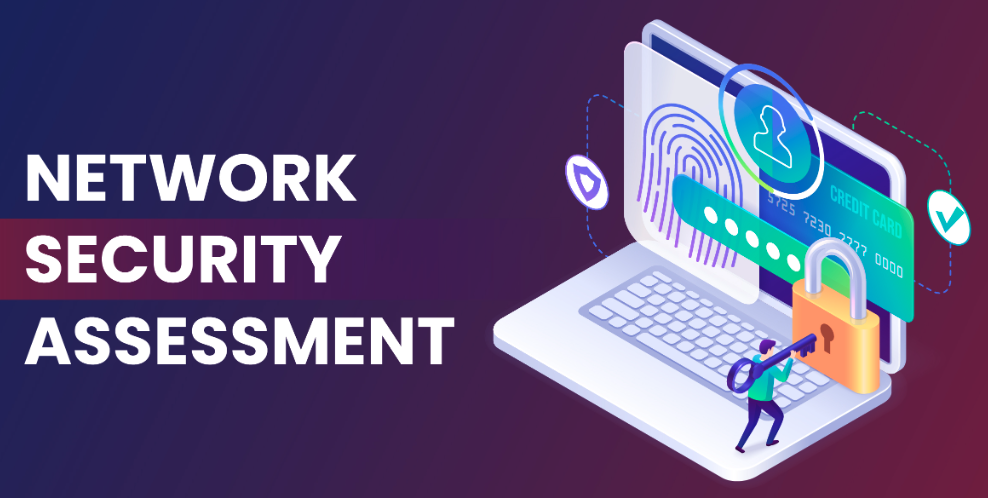

Network Security Assessment (Image by travelers)
A Network Security Assessment (NSA) is a process for ensuring the safety and integrity of an organization’s IT network. Of course, several steps are involved in the network security assessment process. So, let’s take a closer look at what a network security assessment is here.
First, the NSA serves as an audit of the network’s security measures, aiming to discover vulnerabilities that could be exploited, potentially harming business operations or exposing sensitive information.
The NSA thoroughly examines the organization’s IT network infrastructure, protocols, and configurations.
The NSA’s primary goals are to uncover hidden vulnerabilities, assess the level of risk, and suggest actionable remediation plans.
Regularly conducting network security assessments (NSAs) is important for maintaining robust network security. Identifying and addressing vulnerabilities helps organizations protect their assets and ensure business continuity.
Why are Network Security Assessments Important?
Network security assessments are essential because they systematically scrutinize your organization’s IT network to uncover vulnerabilities.
These evaluations are pivotal in identifying weak points that could be exploited by cyber attackers, potentially leading to data breaches or operational disruptions.
Businesses can proactively address these security gaps by conducting these assessments, ensuring robust protection against evolving cyber threats.
During a network security assessment, you identify specific areas that require improvement.
The broader scope is the IT security framework, which guides how to systematically and effectively address these issues.
This practice not only safeguards sensitive information and maintains business continuity but also aligns with best practices in digital security management, making it an indispensable part of modern business strategy.
How does a Security Assessment Work?
A security assessment begins with a thorough examination of your organization’s entire IT infrastructure. This process involves checking all the networks, systems, and devices for potential vulnerabilities.
The assessment team, usually comprising security experts, employs various tools and techniques to scan for weaknesses.
They look into how your network is configured, the kind of software you use, and how your data is managed and protected.
The team then tests these vulnerabilities to see how they might be exploited in a real-world scenario.
This testing is crucial as it reveals a security breach’s weaknesses and potential impact.
Once the assessment is complete, you receive a detailed report. This report outlines the found vulnerabilities and provides recommendations for fixing them.
NSA provides detailed information to guide and refine the broader IT Security Management strategy.
They ensure that management efforts are targeted and effective, keeping the organization’s digital environment secure against evolving threats.
What Are the Techniques of Network Security Assessment?
Assessing your network’s security requires a tailored approach. Various techniques provide distinct insights into different aspects of your defenses. The network security assessment toolbox has two key players.
Vulnerability Scanning
Vulnerability scanning is a method in which specialized software automatically scans your network for known vulnerabilities.
This process involves checking your systems against a database of known security issues to identify potential weak points.
It’s akin to a diagnostic tool that quickly pinpoints areas needing attention, allowing your IT team to address these vulnerabilities before they can be exploited by cyber attackers.
Penetration Testing
Penetration testing, on the other hand, is more hands-on. In this approach, security experts actively try exploiting your network’s vulnerabilities, simulating a real-world cyber-attack.
This technique uncovers weaknesses and tests the effectiveness of your existing security measures.
It provides a practical insight into how a real attacker could breach your network, giving you a clearer understanding of the potential risks and how to mitigate them effectively.
How to Conduct a Network Security Assessment
A network security assessment is essential for any organization that values data security.
Just like giving your network a thorough tune-up, it’s designed to identify vulnerabilities and weaknesses before attackers can exploit them.
Below is a 7-step guide to conducting a successful network security assessment.
1. Define the Scope of the Assessment
Before diving into a network security assessment, defining what parts of your network will be assessed is crucial.
This includes determining which systems, networks, and data are critical to your business operations.
Setting a clear scope ensures the assessment is focused and effective, covering all vital components without wasting resources on non-essential areas.


2. Gather Network Information
The next step is to gather detailed information about your network. This involves documenting your network’s architecture, including all hardware and software components.
It’s important to understand how these elements interact and what their role is in your network. This comprehensive overview aids in identifying potential security gaps.
3. Conduct Vulnerability Scanning
Vulnerability scanning involves using specialized tools to identify known security weaknesses in your network.
This automated process scans your systems, applications, and network devices, flagging vulnerabilities like outdated software or misconfigurations. It’s a critical step in uncovering potential points of exploitation.
4. Perform Penetration Testing
Penetration testing simulates a cyber-attack on your network to exploit vulnerabilities. Unlike vulnerability scanning, penetration testing is an active process.
It reveals weaknesses and tests your network’s ability to withstand real-world attacks. This step provides valuable insights into your network’s defense capabilities.
5. Analyze Security Policies and Procedures
Assessing your current security policies and procedures is vital. This involves reviewing your security protocols, incident response plans, and user access controls.
The goal is to ensure that your policies are robust, clear, and effectively implemented across your organization.
6. Review Physical Security Measures
Physical security measures are often overlooked in network security assessments.
It’s important to evaluate how well your physical infrastructure (like server rooms and data centers) is protected against unauthorized access, damage, or theft.
This step ensures that your network’s physical components are as secure as its digital ones.
7. Prepare and Review the Assessment Report
After completing the assessment, the final step is to compile and review the findings. This report should detail discovered vulnerabilities, the potential impact of these weaknesses, and recommendations for remediation. It’s a roadmap for strengthening your network’s security and should be used to guide your future cybersecurity strategies.
Having walked through the seven essential steps of a network security assessment, it’s clear that this process is more than just a technical exercise.
But remember, the journey doesn’t end with identifying and analyzing vulnerabilities. The real impact comes from what you do next.
This brings us to some crucial additional tips that bridge the gap between assessment and action.
Firstly, getting everyone on the same page is key. Network security isn’t just an IT issue; it’s a company-wide priority.
So, ensure all stakeholders, from management to staff, understand the importance and are committed to improving your security posture. It’s about creating a culture of security awareness.
Next, communication is crucial. Don’t let the findings of your assessment gather dust.
Share the results openly with key stakeholders, ensuring everyone knows the risks identified and the steps needed for remediation.
Lastly, remember that time is of the essence. Addressing network security vulnerabilities is not something to be shelved for later. The risks are real and immediate, so swift action is essential.
Integrate these tips with the seven steps to actively fortify your network against the evolving threats of the digital world. Assessing alone is not enough.
Conclusion
In 2024, it is important to acknowledge the importance of network security assessments in protecting our digital infrastructure.
Through the methodical evaluation of vulnerabilities and potential threats using techniques such as vulnerability scanning and penetration testing, organizations can strengthen their defenses against ever-evolving cyber threats.
Remember, NSA is about a continuous process of learning, adapting, and enhancing security measures. Therefore, you should actively integrate these practices into your business security strategies.
Strengthening network security is a proactive step towards a more secure and resilient digital environment for everyone.








